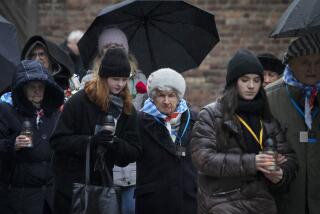30th Anniversary for Berlin Wall : Germany: The people remain divided despite the collapse of the infamous barrier in 1989.
- Share via
BERLIN — Amid a bittersweetness that has characterized so much of unification, Germans on Tuesday commemorated the 30th anniversary of the Berlin Wall in the knowledge that, while the infamous barrier has all but disappeared, as a people they remain deeply divided.
In speeches, published statements and an array of newspaper special reports, the anniversary was used as much to highlight those cultural and psychological divisions that still separate the Germans as to remember the physical wall that has since disappeared.
Speaking at a ceremony near the spot where an 18-year-old East Berliner was shot by East German guards in August, 1962, as he tried to scale the wall and was left to bleed to death, Berlin Mayor Eberhard Diepgen called the barrier a declaration of the political and moral bankruptcy of the East German Communist regime.
“Now, after this state has collapsed and our people are united, we face the difficult task of rebuilding Germany’s ‘inner unity,’ ” Diepgen said. “We can only succeed in this if we understand that the realization of this unity and remembering the past are closely linked. The postwar era really only comes to an end once we’ve achieved a unity within ourselves.”
Added German Interior Minister Wolfgang Schaeuble: “There is still much to do, not only in the East but equally so in the West.”
In the 21 months since the wall collapsed, the Germans have come to learn that they are in many ways two very different people, with Westerners viewing their eastern cousins as naive, ignorant and timid, while Easterners nurture the image of an aggressive, know-it-all West German.
“The wall in our heads is higher than ever,” declared a coalition of east German grass-roots political groups in a statement timed to commemorate the wall’s anniversary.
While the emotional distance between eastern and western Germans marks much of the rhythm of daily life in the German capital, the Berlin Wall has all but disappeared.
Of the original 100-mile-long wall that the East Germans began building around West Berlin in the early hours of Aug. 13, 1961, only a little over 2 miles remain in the central part of the city, although longer stretches remain in the outskirts.
More than a mile of this inner-city wall has become a large outdoor gallery, where more than 100 artists from 21 countries have painted more than 100 pictures.
Since the first concrete section was taken away in February of last year, removal work on the rest of the wall has been so extensive that when the Berlin city authorities announced plans Tuesday to erect a memorial, they explained that a 420-foot-long section would have to be reconstructed at the planned site.
The memorial will be built along the Bernauer Strasse in the Wedding district of the city, where eastern residents made dramatic leaps to freedom from upper-story windows during the wall’s first hours as the Communist authorities frantically worked to seal off the eastern part of the city.
The decision to erect the memorial, including the reconstructed wall section, was strongly opposed by local residents, who argued that they had lived with the barrier at their doorsteps for more than 28 years and wanted no memorial to remind them of it.
Tuesday’s anniversary also brought renewed demands for prosecuting those East Germans responsible for the estimated 80 deaths that occurred at the wall.
The calls highlighted the fact that, so far, no prominent member of the former East German hierarchy has been convicted of crimes committed while in office.
Former party leader Erich Honecker was accused of issuing shoot-to-kill orders along the wall, but slipped out of Germany last year to Moscow as Berlin prosecutors moved to issue a warrant for his arrest.
Other former East German leaders, including ex-Prime Minister Willi Stoph and the security police chief Erich Mielke, have also been linked with wall killings, but have so far evaded trial.
Legal proceedings are expected to begin next month, however, against three former border guards accused of killing 20-year-old Chris Gueffroy in February, 1989. He is the last known person to die at the wall.
Berlin judicial authorities say gathering evidence to link specific East German guards with specific killings is extremely difficult and often must be reconstructed from notes in border unit logbooks.
Construction of the Berlin Wall, a barrier that effectively cut in half a city of more than 3 million people, marked one of the more ambitious, if infamous, projects undertaken by the Communist East German regime.
Work began shortly after midnight, and by the time of the morning rush hour, the city had been severed.
The Berlin city police Tuesday opened a permanent exhibition of files, reports and orders from both East and West Berlin authorities during the days before and after the wall went up.
One entry from the western police substation in the Spandau district noted that urban railway trains from the east had inexplicably stopped running. “Cause unknown,” the officer wrote.
Declared a success by the East Germans, the wall eventually came to symbolize the failure of Communist ideology.
After the wall was breached in the midst of East Germany’s 1989 revolution, tourists and curiosity-seekers came from around the world to chip off a piece of the reinforced concrete for their living rooms.
Pieces of the wall are still sold by peddlers for $2 to $3 a chunk near Brandenburg Gate.
Just last week, the federal government released to an eastern German charity $1.2 million in revenues earned from selling off entire sections of the wall.
More to Read
Sign up for Essential California
The most important California stories and recommendations in your inbox every morning.
You may occasionally receive promotional content from the Los Angeles Times.













